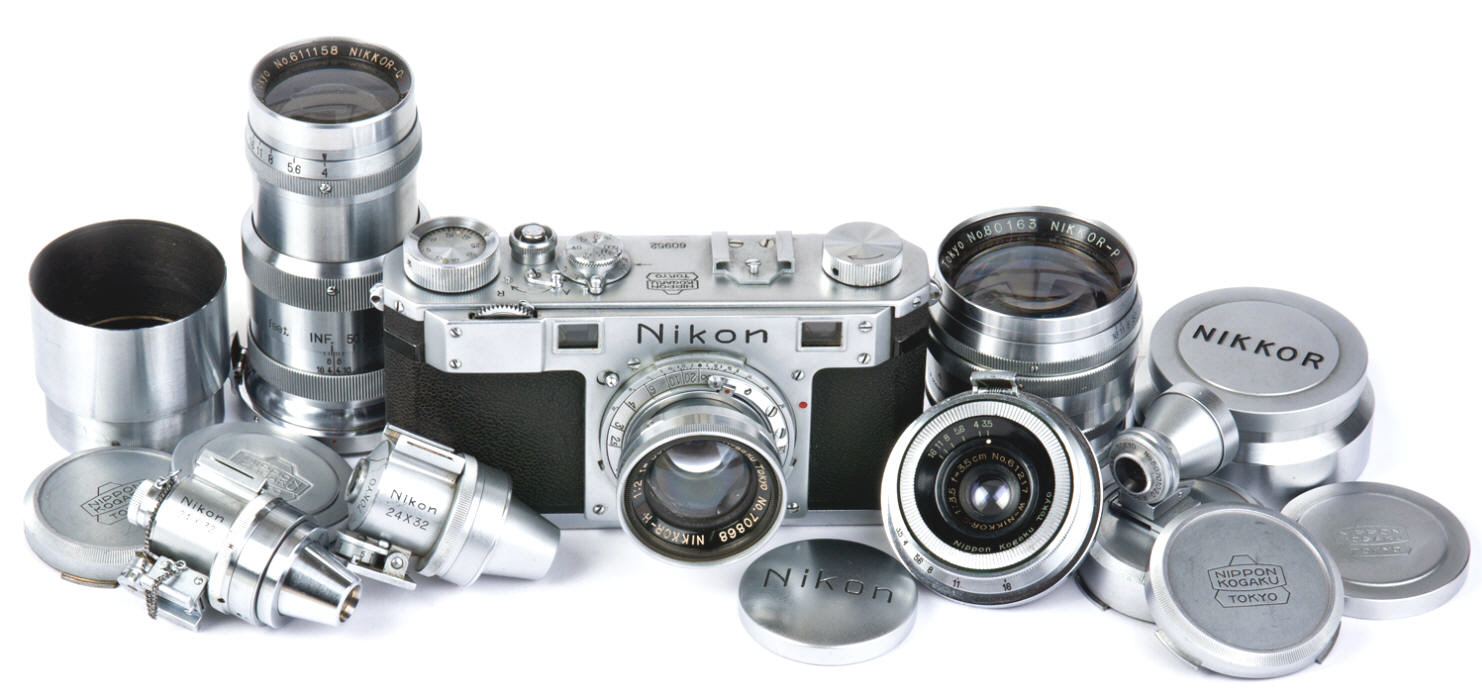
CameraQuest Home Shopping Cart Price List Camera Articles I Buy / Wants Repairs Books Adapters
Nikon One: The First Nikon
Nikon One Mystery Nikon One 609350 Nikon One Garage Sale

First produced in March 1948, the Nikon One was Nippon Kogaku's first 35mm camera, as well as their first rangefinder. Today, over a half a century later, the Nikon One is among the most sought after and rarest collectible cameras of any type, not just Nikon. The times were very different when this camera was made. In a heavily bombed and American military occupied post war Japan, it was on this camera Nippon Kogaku management bet the future of their company on, and won. Not knowing if their new camera would be a success or failure, the venerable optical firm of Nippon Kogaku called their new camera "the Nikon." As time went by, the firm was renamed to match the camera. Nikon rangefinder collecting is very popular, second only to Leica collecting. Due to Nikon popularity and many Nikon shooters eventually becoming Nikon collectors, the Nikon One is one of the most sought after of all collectible cameras. The very early 35mm, 50mm 85mm and 135mm Nikkor lenses share early production characteristics including extremely heavy front and back caps (except 50mm which apparently did not have a Nikon One era rear cap), style of lettering, unique Nippon Kogaku engraved rear caps (except 50mm), and very prominent MADE IN OCCUPIED JAPAN engravings. As production continued the MADE IN OCCUPIED JAPAN engravings became less conspicuous and finally disappeared.

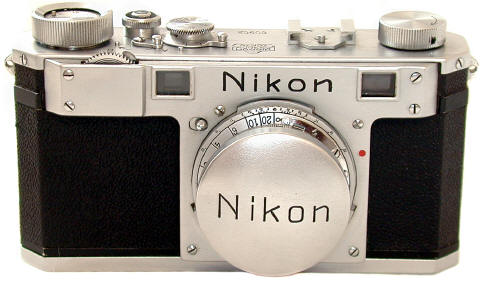
The Nikon One design is a curious mix of the best pre-war German 35mm rangefinder designs, Leica and Contax. Nippon Kogaku designers generally combined the best of both systems, with one unfortunate crucial exception - the lens mount. 60952 is the last known Nikon One with EIGHT screws on the faceplate. Later Nikon Ones have six screws securing the faceplate.
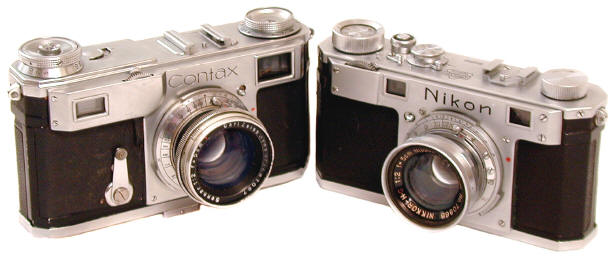
The 1936 Zeiss Contax and the 1949 Nikon One, both mounting 50/2 collapsible lenses. Do you notice any similarities?
In practical terms, the Nikon One can be considered a Zeiss Contax II with Leica style modifications
Zeiss Contax shaped body with double lock removable back for easy film loading (as opposed to the bottom film loading of the smaller bodied screw mount Leicas)
Zeiss Contax type bayonet lens mount system, with a modified focusing helical, even down to the Contax style index finger focusing for normals and wides
Leica style horizontal traveling cloth shutter, instead of the more complicated and more expensive vertically traveling metal Contax style shutter, offering a range of 1 second to 1/500th
Top deck shutter speed dial, with separate low and high speed dials. This contrasts with a single combined shutter speed dial on the pre-war Contax, and separate low and high speed shutter dials on pre-war Leicas
Modified Leica style rangefinder and viewfinder, with a combined RF/VF like the Contax, instead of separate rangefinder and viewfinder windows like Leica
24x32 film format instead of the standard 35 format of 24x36. The odd 24x32 film format led to the Nikon One's quick demise. The American occupation forces under General MacArthur would not allow the I to be exported to the US, because the film would not fit standard 24x36 Kodak slide mounts. The One was discontinued in August 1949 to be replaced with the very similar design Nikon M with a larger 24x34 film format.
Original 5 Nikkor lens lineup: 35/3.5, 50/3.5 collapsible, 50/2 collapsible, 85/2, and 135/4. All lenses were coated, generally copies of pre-war Zeiss designs.
If you are brand new to collectible cameras, there is no built in exposure meter, motor drive, or autofocusing. The photog has to do all those things themselves. Yet, for its time, the Nikon was one of the world's leading camera designs.
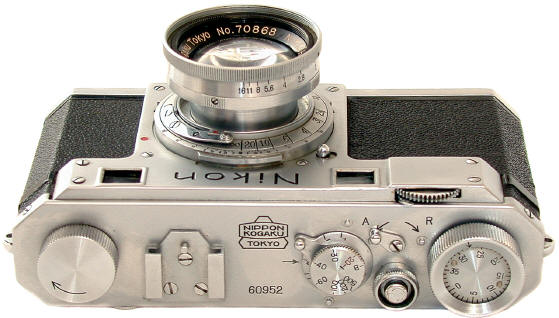
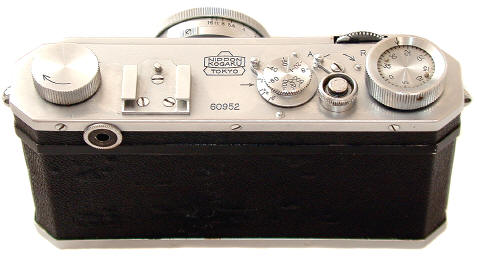
Nikon One serial numbers started at 6091 and went to about 609759. The first 21 cameras are believed to be used for test purposes. By this accounting, number 60952 would be the 31st production Nikon camera, produced in May 1949. Although the numbers would seem to indicate over 750 Nikon One's, it is actually much rarer according to Robert Rotoloni, founder of the Nikon Historical Society. He believes the number of Nikon One's actually delivered is closer to 400, due to 90 Nikon One's not passing quality control, and about 200 unsold I's being converted to the later Nikon M. The film format change was mandated to accommodate standard American format Kodak Kodachrome slides so Nikon cameras would be eligible for export to the US.
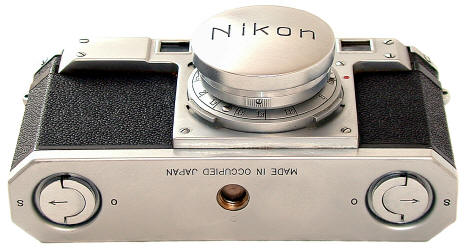
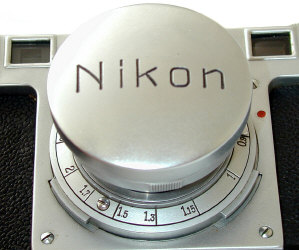
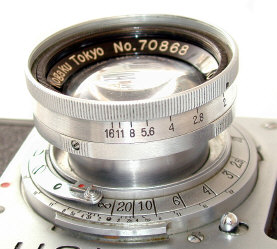
50/2 Nikkor Collapsible # 60921 is reported on camera number 60941, lens number 60969 on camera number 609111, and lens number 60990 on camera 60926. Shown above on camera 60952 is lens number 70868, the 69th lens of this second numerical sequence. This seemingly random intermixing of the 609xx and 708xxx lenses over only 111 cameras suggests both numerical 50/2 collapsible lens 609xx and 708xxx lens batches may have been completed very early in Nikon One production, and then mounted randomly to whatever camera was ready for delivery. The very early dome Nikon lens cap is extremely difficult to find, actually much rarer than the camera since they were lost so easily. The top pic shows the lens collapsed back into the body for more compact carrying (but not picture taking). Incidentally, the domed cap above was only made for the earlier Nikon One 50/2 and possibly 50/3.5 lenses. I don't know when the change occurred, but by 609200 or so, the flat lens cap seems to be in use.
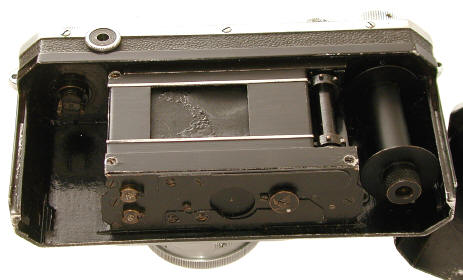
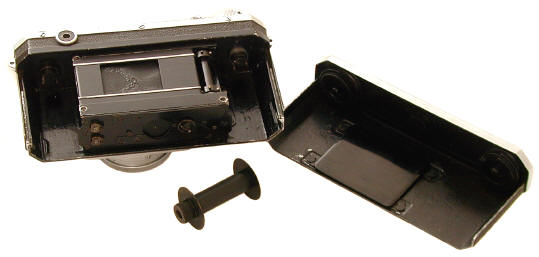
The interior film chambers of early Nikon One's are crudely finished. The finish is uneven and hand painted. There is no bottom cover plate to protect the shutter tension adjustments. 60952 has only one set of film rails, instead of the two sets of two rails like later cameras. The film sprockets are smaller and on a smaller diameter spool than later cameras. As you can see, the original curtain on this camera is in rather bad shape. The curtain material for the Nikon One and later Nikon M was not of the best quality. Note the removable film spool -- like the Zeiss Contax. The removable take up spool is only found in the early bodies with early body castings.
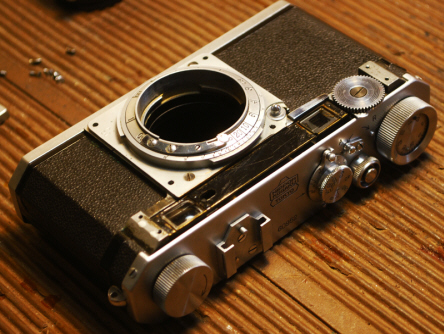
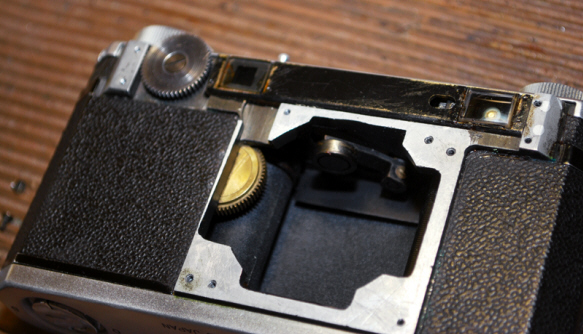
Notice the body casting of 60952 is not numbered while 609350 does have a numbered body casting - possibly indicating number parts locations may have been as the individual camera assembler deemed necessary to fit the needs of the assembly process.
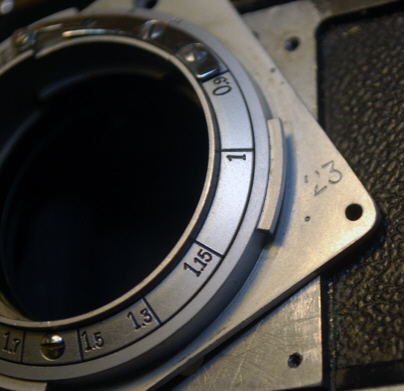
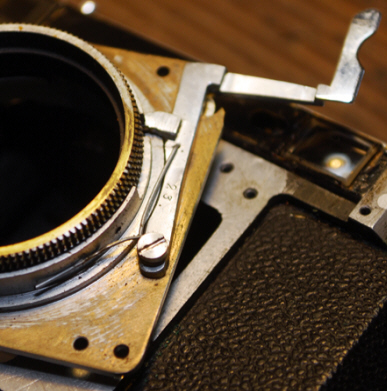
Number 23 on the front of the focusing helical plate and on the back of the infinity finger lock Notice the rough filing marks on the body's focusing mount seat.
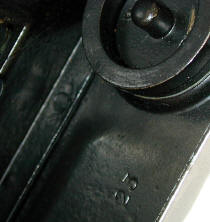
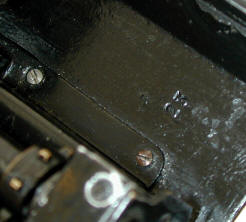
Number 23 on the bottom of the inside of the camera back and inside the film take up chamber. Note the very crude hand done finishing inside the back and film chamber.
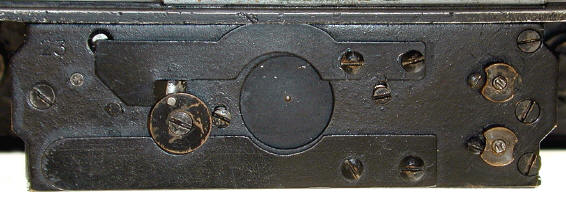
Number 23 on the bottom shutter assembly cover. Unlike later Nikon One's, there is no bottom shutter assembly cover.
Not ALL Nikon One's have the top plate serial number stamped on the back!
Many Nikon fans believe all Nikon One's, M's and S's have matching serial number engraved on the top plate and stamped into the detachable film back. Surprisingly, this is NOT TRUE. Most early Nikon Ones in the first 50 or so do not have the top plate serial number stamped into the back. More research needs to be done, but this is true of at least cameras 60952 and 60926. Apparently an unknown number of very early I's were produced before Nippon Kogaku decided to standardize numbering with matching top plate and back numbers.
Instead of "60952" on the back, the number "23" is stamped on at least 5 locations: the camera back, inside the film chamber, the bottom of the crudely finished shutter assembly, the front of the lens helical casing, and on the back of the lens infinity locking lever. Is this proof the un-numbered body casting is also number 23? No, but until #23 body casting is discovered (if ever), the same five internal numbers on a Nikon One body is a pretty good indication that those numbers do indeed indicate the camera production order. To date no other Nikon One has been found to have the same number internally engraved five times! I take these numbers to indicate that beneath top plate 60952 (the 52nd Nikon) is Nikon # 23 - the third production Nikon camera. Without a lot more research of course, these possibilities are hardly proven.
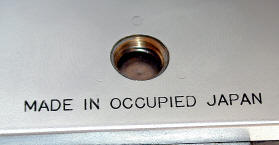
The MADE IN OCCUPIED JAPAN engraving indicated the American post war occupation of Japan, which ended in September 1951. The large MIOJ engraving shown above was switched to much smaller MIOJ lettering on the baseplate, possibly within the first 100 cameras. Eventually during Nikon M production, the MIOJ engraving was moved to an imprint on the back leather, where it was much harder to see.
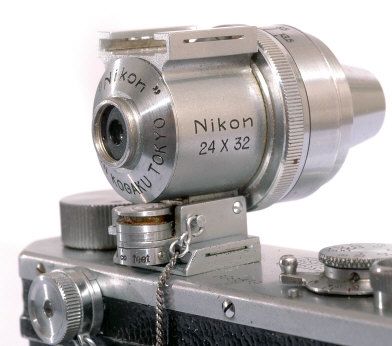
As incredibly rare as the Nikon One is, the 24x32 format Variframe 35/50/85/135 Viewfinder made for the One is actually rarer -- in my experience anyway. The viewfinder frame was selected by rotating the viewfinder barrel to the desired frame. Parallax was adjusted by rotating the lever on the rear base of the viewfinder to the focused distance. Notice this 24x32 viewfinder is marked in feet. Nippon Kogaku was already thinking about export sales. A small chain attached the rangefinder magnifier to the viewfinder. The magnifier could be left on the viewfinder for storage, attached to the camera for magnifying the RF image. Later Variframe variations were made as late as Nikon S2 production, without the 24x32 designation. Most Variframe viewfinders are found today without the chain and magnifier.
IF the Nikon One used the Zeiss Contax mount, why isn't it fully compatible with Zeiss Contax Lenses?
The Nikon rangefinder lens mount, introduced on the Nikon One, LOOKS like the German Zeiss Contax lens mount. Nikon Rangefinder lenses will mount on the Contax, and vice-versa. How could Japanese camera manufacturers copy patented German Leica and Zeiss camera mounts in the first place? The short story is that in a post WWII environment, the winning Allies allowed it in the interest of getting bombed out economies up and running again. This is a very complicated issue about which books have been written, but I don't care to get more into it here.
If it quacks, it might NOT be a duck. Looks aren't everything after all. Much to the irritation of photographers, Nikon rangefinder lenses mounted on Contax, or Contax lenses mounted on Nikon rangefinders, are NOT FULLY COMPATIBLE. Sometimes the pics can be out of focus. Hmm. Both the internal mount and external mount lenses fit just fine. The lens back focus is the same. Yet the lenses may not focus accurately.
How could Nikon copy the Contax lens mount and NOT get it right? Like many questions, the answer depends upon how you interpret the data. For me, comically the fly in Nikon's soup is Canon -- a situation that continues to this day with their intense competition! Nippon Kogaku had never built a 35mm camera before, but before the war and up to early 1949 Nippon Kogaku did supply 50/3.5 or 50/4.5 Nikkors for the Canon Hansa, S, J, NS, JS, S-1, J-II, S-11. The Canon is considered a modified Leica copy, thereby using the Leica standard for "50 mm" normal lenses --- 51.6mm. The Zeiss Contax uses a nominal focal length of 52.3 mm for its "50 mm" normal lenses. In one of Nikon's biggest foul-ups ever, Nippon Kogaku decided to use the 50/3.5 Nikkor already developed for the Canon, for the new Nikon camera. In 1949 there was no guarantee the new Nikon camera would be a success. Perhaps due to lack of space, or investment capital, the decision was made to use the Leica (by way of Canon) inspired 51.6mm as the Nikon One's normal lens focal length. If the new Nikon camera went belly up, Nippon Kogaku could still remount Nikon normal lenses to Leica screw mount. For most of the 1950's Nippon Kogaku continue to hedge its bets by producing Leica screw mount lenses along side the Nikon mount lenses. A better long term solution was using the Zeiss Contax standard 52.3mm focal length for normal lenses on the new Nikon camera -- this would have allowed full lens interchangeability between Nikon and Contax.
OK, the differences between 51.6mm and 52.3mm, so what? Well, remember the Zeiss Contax uses a focusing helical IN THE CAMERA body for normal lenses, so the Nikon One used the same type of helical. Alas, what happens when you put a 51.6mm lens in a focusing mount intended for a 52.3mm lens? While infinity is in focus providing the back focus is the same, the other focused distances are slightly out of focus on the film plane. This is especially noticeable at full aperture and close up -- where the difference can not be carried by depth of field.
The solution? Just change the Nikon helical so the 51.6 mm lens can be focused to 3.5 feet, and adjust the rangefinder mechanism accordingly.
The problem created by the "solution" is that ALL Nikon rangefinder lenses have to mate to the internal normal lens helical in order to focus the rangefinder. In other words, changing the Nikon rangefinder normal lens to make it compatible with the made for Canon Leica mount normals, also forced helical changes for ALL other Nikon rangefinder lenses. For 35 and shorter lenses, the difference is so small as to normally be considered inconsequential, allowing for the interchangeability of Nikon and Contax wide angles. With 50mm and longer lenses, the difference begins to add up so that wide open and close up, Nikon and Contax lenses are not compatible. But if you shoot at medium and longer distances, or at medium or smaller apertures, depth of field will usually take care of the focus error. As focal length increases, the problem increases, to the point that Nikon made special 85/2, 105/2.5, and 135/3.5 lenses for Contax, so marked on the lens barrel with a "C."
OK, if I wrote this carefully, you probably now understand the reason for the lens incompatibility problems. The big question is WHY would Nikon intentionally make the lenses of their new camera incompatible with the lenses of the mount they have just copied. It would seem to make no sense at all. If you read official Nikon literature, the WHY is usually lightly glossed over. I would imagine the reason are a big embarrassment now. It would seem Nippon Kogaku management had little confidence of the future of their new Nikon. One possibility is that they hedged their bets by making Nikon camera lenses more easily Leica compatible, so that if the Nikon camera died, Nippon Kogaku would more easily have Leica mount lens sales to fall back on. Another possibility is that economic savings of not having two standard 50mm focal length lenses (51.6 vs. 52.3) was placed ahead of long term Nikon customer interest and satisfaction in having their lenses 100% compatible with Zeiss Contax lenses.
Nikon One's are about five times rarer today due to American occupying forces not liking the 24x32 film format. Without the change of film format, the Nikon One and unsynced M would merge into one camera with a production of about 2000 cameras, instead of about 400 Nikon One's and 1591 unsynced Nikon M's. Ironically Nikon seems to have gotten into film format problems by copying Minolta's 24x32 format from Minolta's first 35mm camera, the 1947 Original Minolta A, a Leica screw mount copy. Minolta's founder Mr. Tashima is generally credited with inventing the 24x32mm "Nippon size" film format. Minolta's Leica screw mount rangefinders proved far more popular than Nikon rangefinder during the American occupation. Approximately 4000 Nikon rangefinders were "Made In Occupied Japan " (Nikon One, unsynced and synced M, very early S). Over 20,000 MIOJ Minolta Rangefinders were produced (Minolta A, B, C, D, E, and some F's). About the first 3,000 Minolta A and B's used Mr. Tashima's 24x32 film format. Unlike Nikon, Minolta did not export to the US during the MIOJ period.
Nippon Kogaku (name later changed to Nikon), had two basic problems with the Nikon One: the 24x32 film format, and the close but incompatible with Zeiss Contax, Nikon lens mount. Ironically, both mis-steps came about by following in the footsteps of Canon in lens design and Minolta in film format choice. While early Nikon's miscues may seem hilarious to Canon or Minolta fans, in 1949 both Minolta and Canon were established 35mm camera companies. In contrast, Nippon Kogaku had a non-existent 35mm camera track record, and faced a very un-certain camera manufacturing future. For all of that, Nikon collectors got the last laugh. Even the pre-war original Canon Hansa sells for much less than a Nikon One, while MIOJ Minoltas sell at a small fraction of similar MIOJ Nikons due to lack of demand.
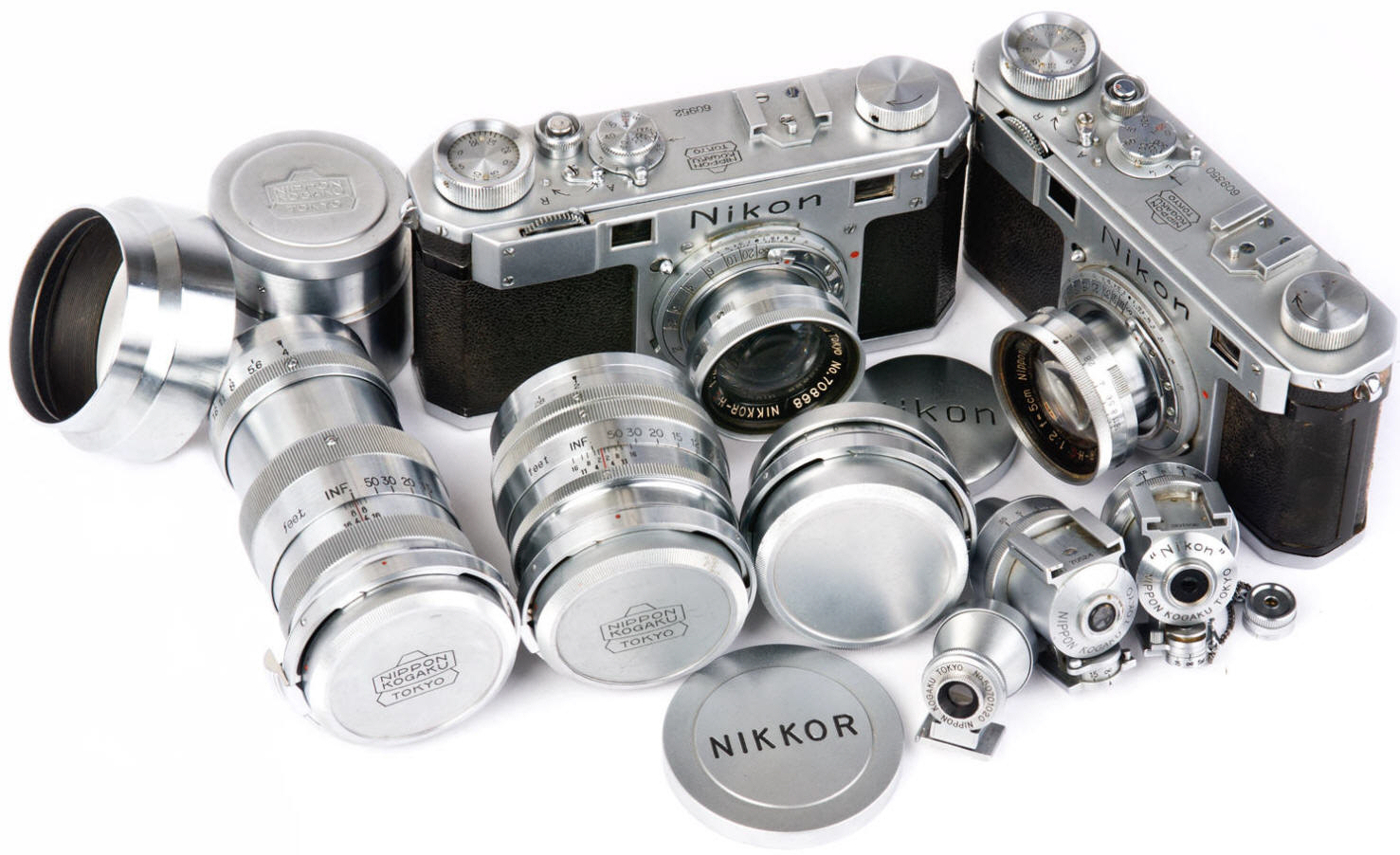
When the Nikon One was first introduced to the public in August 1949, no one in their right mind would have predicted its place in 35mm history, or its popularity with collectors today.
It would seem Nippon Kogaku's first 35mm camera turned out pretty well.
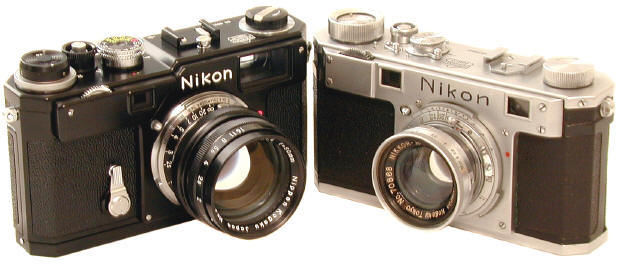
The black S3 2000 and the Nikon One of 1949.
Nikon surprisingly reintroduced Nikon Rangefinders with the Nikon S3 of 2000 and the Nikon SP of 2005!
The original Nikon One dome lens cap and the Nikon One's yellow instruction booklet are both VERY rare today, even though an unknown number of Nikon One instruction books were supplied with later unsynced Nikon M's. So far as I am aware, there is only one version of the Nikon One instruction book in English.
Voigtlander Nikon/Contax Rangefinder Cameras and Lenses
Voigtlander Bessa R2S R2C Rangefinders in Classic Nikon or Contax Rangefinder Mounts
Voigtlander Bessa R2S 50/3.5 Heliar S NHS Commemorative in Classic Nikon Rangefinder Mount
Voigtlander SL 12/5.6 and 15/4.5 Aspherical widest EVER for NRF
Voigtlander Nikon Rangefinder SC Mount Lens Intro 21/4, 25/4, 35/2.5 intro
Voigtlander Nikon Rangefinder SC Lenses: SC 21/4, SC 25/4, SC 28/3.5, SC 35/2.5, SC 35/1.2 Prototype, S 50/1.5, S 50/2.5, S 50/3.5, S 85/3.5
Voigtlander VC Meter II small compact silicon meter with LED readout for Nikon Rangefinders
CameraQuest Home Shopping Cart Price List Camera Articles I Buy / Wants Repairs Books Adapters
Revised: September 12, 2017 . Copyright © 2002-2016 Stephen Gandy. All rights reserved. This means you may NOT copy and re-use the text or the pictures in ANY other internet or printed publication of ANY kind. Information in this document is subject to change without notice. Other products and companies referred to herein are trademarks or registered trademarks of their respective companies or mark holders.